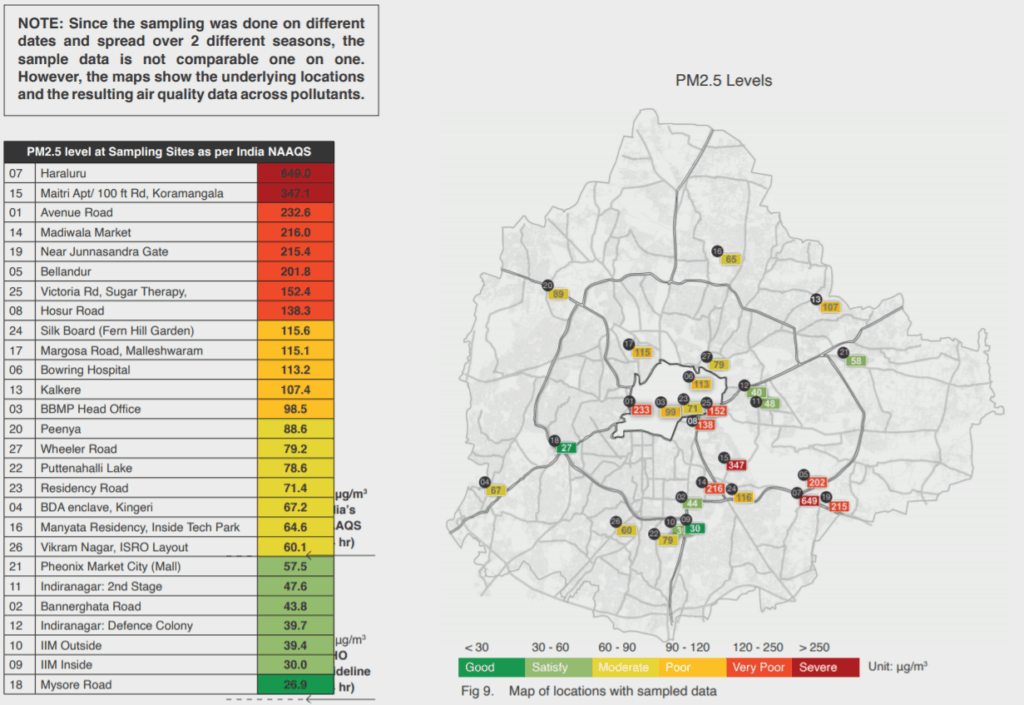A report titled ‘Choking in the Garden City’ released by Sensing Local and Healthy Energy Initiative India, has analysed 24-hour air samples of PM 2.5 from different parts of the city. The authors of the report highlight that the main objective of the study was to understand the source contributors to air pollution at a local level, how they differ from one place to another based on land use, road hierarchies and other variables, and to highlight health effects due to specific elements present in the air.
Apart from PM 2.5, elevated levels of heavy metals such as manganese, nickel, lead and crystalline silica were found in the samples. Manganese and lead are neurotoxins, while crystalline silica is a respiratory irritant, and can cause silicosis, a fatal disease generally known to only affect people exposed at workplaces.
“The results have demonstrated that the PM2.5 levels in almost all sites tested exceed the statutory regulations. Presence of toxic chemicals like lead, manganese, nickel indicate that threat to air quality and health is not just from PM2.5 but from toxic heavy metals that do not get accounted for,” says the report.
According to Ankit Bhargava of Sensing Local, “This study is unique because it brings together various stakeholders – the impacted communities, health experts, environmental experts and urban planners to collaboratively work towards identifying the problems of air pollution and finding solutions to it.” Ankit further added that, “given that the data is local, the idea was that citizens would better relate to issues specific to their street/neighbourhood/ward while also recognising common sources that require citywide action”.
The 27 sampling sites were strategically selected as community-based locations, representative of varied spatial typologies and neighbourhoods across Bengaluru. There was a mixture of residential and commercial localities including one location at a hospital and another within a designated industrial area.

The finding of the report attains significance in the current COVID pandemic where emerging research indicates that populations residing in regions with air pollution are more vulnerable to the pandemic. Doctors explain this is because exposure to air pollution in the long-term reduces the capacity of organs to function fully and makes them more vulnerable to infections and diseases. In the context of the current COVID-19 pandemic, such individuals are likely to face complications, including serious ones.
“Sampling results indicate that vehicular emissions, re-suspended dust from roads and construction activities are major contributors to air pollution in Bengaluru, manifesting a negative impact on the air quality and threatening public health. Inadequate urban governance and poor urban planning are seen aggravating the already-poor air quality and contributing to toxic heavy metals like silica, iron, manganese, nickel and lead in the air,” Ankit said, “In addition to this, other sources like garbage burning must be investigated into”. The findings also correlate to the sources of air pollution in Bengaluru, highlighted in an earlier study by Urban Emissions and the Center for Study of Science, Technology and Policy (CSTEP).
According to Dr Adithya Pradyumna, an environmental health researcher from Bengaluru, “The findings are of great concern to public health in Bengaluru. Air pollution is the second leading killer in India, and PM 2.5 is the primary contributor amongst air pollutants to morbidity and mortality. Most readings for PM 2.5 from across Bengaluru were found to be higher than prescribed standards, implying ongoing high impact on cardiovascular and respiratory diseases.”
Dr Adithya expressed additional concern on the high levels of heavy metals like lead, nickel and manganese found alongside other air pollutants. He added, “While some of these pollutants haven’t been assigned local standards, they were largely elevated above WHO standards. Especially of concern is lead, which was also found to be high in few samples; it’s capable of irreversibly impacting neurological development among young children. Exposure among children may especially be of concern for schools near main roads, busy junctions, and also where heavy construction and road repair works are underway”.
The report recommends authorities to develop sector-specific plans to reduce particulate matter and heavy metal concentrations. Further, the public health system needs to take note of the presence of these levels of heavy metals and commission a city-wide health survey for follow up of the population indicating long term exposure. Report also recommends that until public health and air quality have been restored, strict regulations to control vehicular emissions and fugitive dust from construction and demolition must be drawn up and enforced.
Background of the report
The study was conducted as a collaboration between Sensing Local, Bengaluru, and Healthy Energy Initiative – India between April-November 2019.
The list of 27 sample sites is as follows: Avenue Road, Bannerghata Road, BBMP Head Office, Bellandur, Bowring Hospital, Haraluru, Hosur Road, two locations in IIM campus (within campus and outside), Indira Nagar 2nd Stage, Indira Nagar Defence Colony, Kalkere, Kengeri (near the railway station), 100ft Road Koramangala, Manyata Residency (inside Manyata tech park), Margosa Road (Malleshwaram), Mysore Road, Peenya, near Pheonix Market City (ITPL Road), Puttenahalli Lake, Residency Road & St Marks Road Junction, Silk Board (Fern Hill Apartments), Victoria Road, Madiwala Market Junction, Vikram Nagar (ISRO Layout), Wheeler Road and Junnasandra gate bus stop (Sarjapur Road).
Download the full report here.
[This article is based on a press release from Sensing Local, and has been published with minimal edits.]
You can die earlier and escape the sufferings of this life faster if you live in these cities.